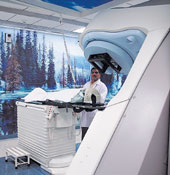 |
| IGRT shows better results when the cancer is in its early phase |
Life went haywire for Ankush Shah’s parents when their seven-year-old boy was diagnosed as having brain tumour. But for correct treatment at proper time, things could have really taken a sinister turn for this happy-go-lucky child.
Ankush leads a normal life today, thanks to the doctors at Pune’s Ruby Hall Clinic’s Cancer Centre. His tumour was successfully removed through Image Guided Radiotherapy (IGRT), a relatively new and technologically advanced form of radiotherapy that is yet to be implemented on a large scale in India.
IGRT is used for treating cancer patients by identifying and mapping the exact shape and position of the tumour, thereby enabling doctors to administer the required doses of radiation with precision.
Says Dr Kumara Swamy, chief radiation oncologist at Ruby Hall Clinic, “The technology, though new in India, is a tried and tested one abroad. It is a better option for those affected with brain tumour as it speeds up the recovery process and provides the patient with an improved quality of life.” Incidentally, the Pune hospital is the first to try this technology in India.
So what gives this technique an edge over others?
The traditional Intensity-Modulated Radiation Therapy (IMRT) method incorporates two distinct features — inverse treatment planning and computer-controlled intensity modulation. While the first feeds a medicine dose to be delivered to a specific area in the body, the second enables the computer to determine the intensity of the treatment. It is a high precision method as it delivers precise radiation doses that conform to the 3D shape of the tumour. It is also the most widely used in the Indian subcontinent, oncologists say.
IGRT is an advancement over IMRT as it maps the precise location of the tumour and also provides the exact dosage of radiation to the cancerous tissues without affecting the healthy ones.
Until now, radiation oncologists have been treating patients with external beam radiation therapy in a mathematically precise way but were unable to see what was being treated. This is because tumours have a tendency to change position between treatment sessions owing to changes in organ filling or breathing. The new technology promises to overcome this anomaly. The change in the position of the tumour can be tracked with a CT image just before treatment delivery and the appropriate corrections made, even online.
Perhaps it is the holistic approach that makes the new therapy an attractive treatment option,” asserts Dr Swamy. Support is also extended to the patient’s family members. The hospital works in coordination with Prasanti Cancer Care Mission, a non governmental organisation in Pune that offers assistance to patients and their relatives, from counselling to rehabilitation.
“The whole process of administrating the radiotherapy takes about six minutes. The patient needs 25 (over five weeks) to 42 (over seven weeks) sittings to get rid of the tumour. The method is still in a trial phase,” says Dr Swamy.
However, oncologists feel that the utility of a technology is measured only by its degree of availability to the masses. Says Dr Gautam Bhattacharjee, head of radiotherapy, Cancer Centre Welfare Home and Research Institute, Thakurpukur, Calcutta,“In India, most of the cancer cases are diagnosed either in the last stage or when the tumour has grown to a considerably large size. And IGRT is not so useful then; it shows better results when the cancer is in its early phase.
“So a mere technological advancement is not a necessary and sufficient condition for effective treatment of cancer,” he says.
Improving infrastructure is of utmost importance in our country where there are a large number of cancer victims. “Only 350 radiotherapy machines are available in the whole country for treating cancer patients. Technological finesse is fine, but it must also be accompanied by measures to make it available to “the masses. This is especially true for our society where many people cannot afford even minimal treatment, let alone counselling and guidance,” asserts Dr Bhattacharjee.
That said, Dr Bhattacharjee is making arrangements for the IGRT method to be available in Calcutta. One hopes this would go a long way in benefiting cancer patients in the city as well as the entire eastern region.










